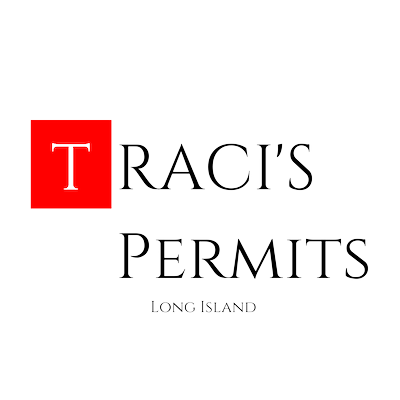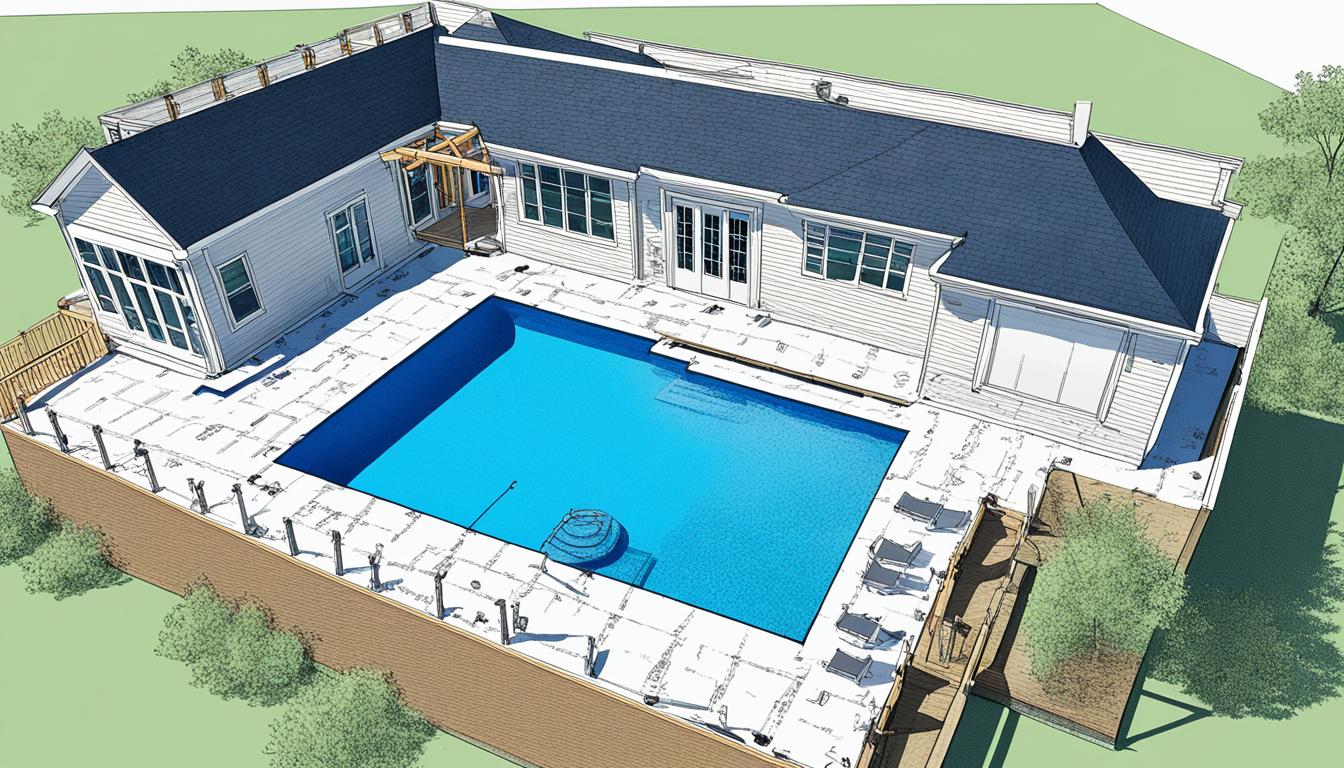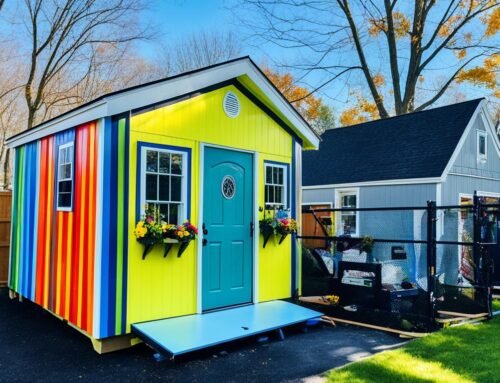Getting a swimming pool permit might take 2 to 12 weeks. This wait surprises many homeowners who are excited to use their new pools quickly. The United States host around 10.4 million residential pools, most are inground. It’s vital to know about getting a permit.
On Long Island, understanding the permit process is key, especially for big projects like pools. Permits make sure your pool meets local safety and building rules. Though the cost varies, getting help from Traci’s Permits can make getting your permit quicker and less stressful.
Key Takeaways
- The average time to get a pool permit is 2 to 12 weeks.
- Permits ensure your pool complies with local codes and safety rules.
- Florida and California have the most residential pools in the U.S.
- The cost of a pool permit is linked to the pool’s value.
- Using services like Traci’s Permits helps speed up the approval.
Understanding the Importance of Pool Permits
Getting a pool permit is more than just following rules. It’s key for safety and following the law with your swimming pools and bathing beaches. By following the New York State pool rules, homeowners protect their responsibilities. They stick to local building laws and keep away from legal troubles.
Why You Need a Pool Permit
The process to get a pool permit in New York helps protect homeowners and their communities. With a permit, your pool will meet all the building laws. This includes the right location, safety for around the pool, alarms, and fences. For example, in Nassair Country, fences around the pool must be at least four feet tall. Pool alarms must be installed to let homeowners know if someone enters the pool area.
Regular inspections make sure your pool stays within the rules. This makes swimming safe for everyone.
Risks of Skipping Permits
Skipping the permit process can bring big problems. Without a permit, your pool might miss important safety checks. This can be very risky. Not following the rules can lead to being ordered to stop work, paying fines, and facing legal issues. Homeowners might also have trouble selling their home or getting insurance later on.
Meeting all pool safety and legal guidelines is very important for homeowners. By getting the right permits and following the rules, you keep everything legal. You also ensure your family and community are safe.
Requirements for Pool Permits in New York
Getting a pool permit process in New York is key for pool owners. Knowing what you need makes getting your permit easier. This is true whether you’re in Long Island or anywhere in New York.
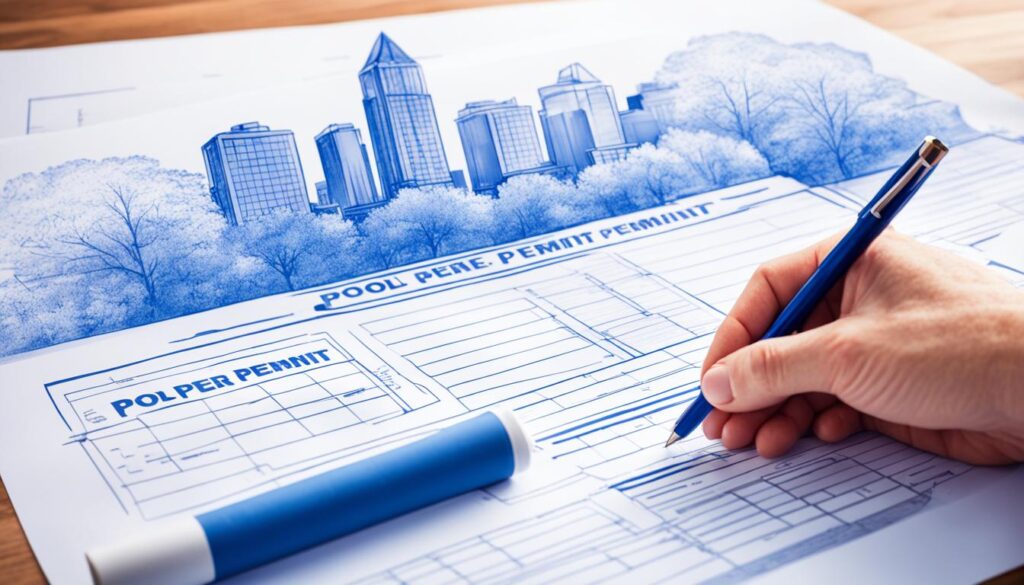
Essential Documentation
When getting a building permit in New York, owners need many important papers. Here’s what you need:
- Two completed Outdoor Water Pool Permit Application forms (87-02).
- Two sets of pool plans showing size, depth, and how it’s made.
- Two Swimming Pool Affidavit (87-03) forms, signed and notarized by you.
- A survey of property lines for correct setbacks.
- Papers for the needed fence around the pool.
Projects like putting in a pool need detailed plans and a list of workers, especially for big jobs. For complex projects, you must hire a Registered Design Professional to get your permit.
Understanding Local Building Codes
Following local building codes is a must in the pool permit process. Here are the main rules for getting a building permit in New York:
| Permit Requirement | Details |
|---|---|
| Ordinary Plumbing Work | No permit required (NYC Administrative Code AC 28-105.4.4) |
| Minor Alterations and Repairs | No permit required (NYC Administrative Code AC 28-105.4.2) |
| Small Pools | No permit needed for pools ≤ 400 sq ft (1 RCNY 101-14) |
| Electrical Work | Requires permit and licensed contractor |
| Setback to Property Line | Minimum five (5) feet for pools and equipment |
| Compliance | Adherence to Article 680 of National Electric Code |
| Limited Plumbing Alterations (Category 1) | $35,000 cost limitation per building within a 12-month period |
| Limited Plumbing Alterations (Category 2) | No cost or time period limitations |
Gather the right documents and follow local codes to make the permit process smoother. No matter if you’re in Long Island or elsewhere in New York, knowing these steps is vital for getting your permit approved.
Creating Comprehensive Blue-Prints
A comprehensive blueprint is essential for getting a pool permit. It needs accurate measurements and scale drawings. These show the proposed pool and any decks or safety features. Making detailed plans helps match building and New York pool rules.
Essential Components of a Pool Blueprint
For New York pool rules, your blueprint must have certain parts. You need:
- Accurate measurements: All sizes must be right.
- Scale drawings: Draw the pool to scale correctly.
- Additional structures: Show decks, barriers, or extras.
- Material specifications: em> List all construction materials.
Tips for Drawing Accurate Plans
Professional help can make your drawings more precise. To make things easier, consider these tips:
- Consult Professionals: Get help from an engineer or architect for all blueprint needs.
- Specialized Software: Use design software for better accuracy.
- Local Guidelines: Check New York’s pool rules to meet all standards.
Knowing about costs and permits is also key. Here’s a table with some fees:
| Permit Type | Fee |
|---|---|
| Building Permit Review – 239F | $1500.00 |
| Dumpster Permit | $418.00 |
| Dye Test | $160.00 – $800.00 |
| GPS Monument Books | $550.00 |
| Industrial Waste Discharge Permit | $213.00 |
| Plans and Specifications | $300.00 |
| Reproduction of Maps | $18.00 per sq. ft. |
Steps to Achieve Quick Approval for Your Pool Permit
Getting a pool permit fast in Nassau and Suffolk County requires good preparation. It’s important to be thorough and detailed from the start. This helps you get through the permit stages quickly.
Preparing Your Application
To start, collect and prepare all needed documents for your permit application. Meeting the local building department’s rules is key. Make sure your plans are precise and follow local and state laws.
Turn in a full package, including essential forms like Form WWM-057 and your design plan. Knowing Nassau and Suffolk County’s rules about pool placement and safety features helps too. This ensures your project follows local laws.
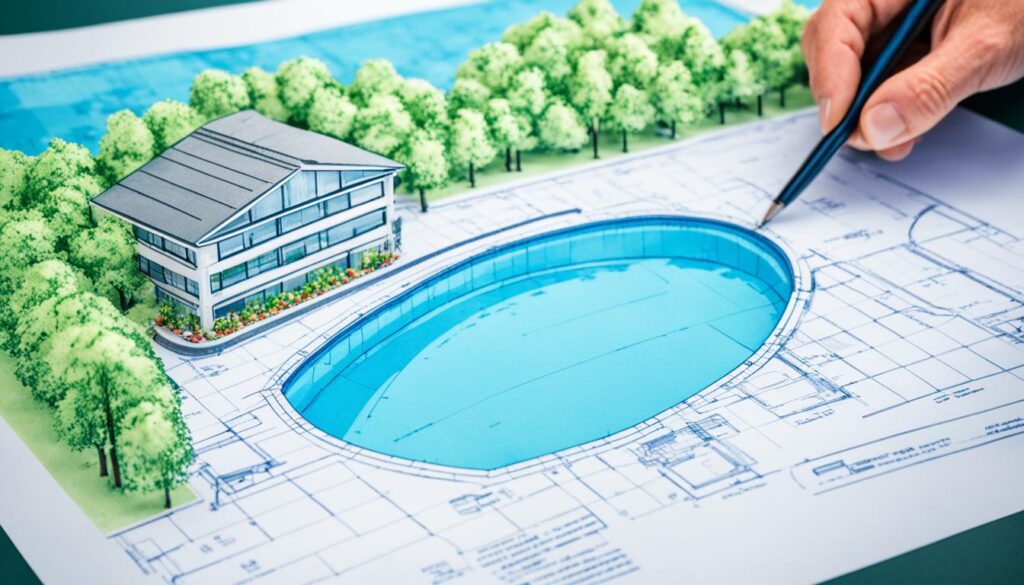
Working with Local Authorities
Building a good relationship with the building department helps. Working well with Nassau and Suffolk County officials makes inspections and approvals easier. Stay ready to answer any questions and make needed changes during the review. Open talks can avoid delays and speed up the permit process.
Hiring a skilled design team familiar with local permits can also help, especially for projects near water or in critical areas. They might need more review, adding time and cost. Yet, their know-how helps make sure your project meets all rules, making approval easier.
| Permit Type | Requirements | Additional Notes |
|---|---|---|
| Swimming Pool | Building Permit | Adherence to setback and safety regulations |
| Fences | Varied permit requirements | Height and placement restrictions |
| Sheds | No permit under 100 sq ft & 10 ft height | Specific setback rules per zone |
By knowing and following these steps, getting your pool permit quickly becomes easier.
Navigating the Pool Permit Long Island Process
Getting through the pool permit process in Long Island may seem hard, but it’s easier with the right advice. This homeowner guide gives you simple steps to follow. It will show you how to comply with New York construction regulations.
First up, you need to do your homework on building department rules and needs. If your pool is over 24 inches deep, you’ll need a building permit. This ensures you meet state and local New York construction regulations. You might also need permits for things like decks, fences, and sheds.
Working with specialized companies like Tracis Permits makes the Long Island pool permit navigation easier. Their experts help you sort through the details of your permit application. They make sure you meet building codes and overcome any barriers.
Getting advice from pros who know Nassau and Suffolk County’s rules can save you from common errors. They know all the crucial details, like pool size requirements. Their knowledge helps make sure your project sticks to New York’s tough regulations.
Pool permits in Long Island last for one year from the issue date. You can renew them for another year. Fees depend on the project’s size, type, and square footage, and you pay when you submit your application. Remember, inspectors have specific time slots to help with compliance.
Inspectors are available during specific hours, from 7:30 am to 8:00 am and from 3:30 pm to 4:30 pm (with adjusted hours in July and August).
It’s critical to know the rules for diving boards and slides too. For example, New York construction regulations say slides must end in at least four feet of water. Details like these are key for making sure your pool complies with the standards.
The table below quickly sums up what projects need building permits:
| Project | Permit Required |
|---|---|
| Decks over 8 inches in height | Yes |
| Fences over four feet | Yes |
| Finished basements | Yes |
| Sheds over 50 sq.ft. | Yes |
| Swimming pools with a depth of more than 24 inches | Yes |
By talking to experts and taking the right steps, homeowners can easily get through the pool permit process. It ensures your swimming pool compliance meets all needed guidelines.
Common Obstacles in Pool Permit Approvals and How to Overcome Them
Getting a pool permit can be tricky for homeowners. Knowing and dealing with these problems is key. This makes the approval process smoother and follows local rules.
Addressing Safety Concerns
One big hurdle is sticking to safety codes for pools. Your pool plan might not meet code requirements at first. For example, Connecticut demands fences around pools to be at least 48 inches tall. New York wants a 4-foot tall fence that closes and latches itself. It’s important to include these details in your plans.
- Connecticut: Fencing 48 inches high, maximum 2-inch ground gap.
- New York: Fencing at least 4 feet tall with self-closing, positive-latching gates.
| State | Requirement |
|---|---|
| Connecticut | Fencing 48 inches high, max. 2-inch ground gap |
| New York | 4-foot tall fencing, self-closing, positive-latching gates |
Zoning rules can also be tough to navigate. In Bristol, Connecticut, pools must line up with the house’s back or deck. They also need to be 5 feet from any property line. Norwalk, CT, has similar rules but with specific distances from property lines.
Handling Revisions and Resubmissions
Dealing with building permit revisions and permit resubmission is another big challenge. If your plans don’t meet standards, be ready to change them fast. Quick changes and resubmitting them help avoid delays. Talking clearly and often with inspectors and permit offices helps a lot.
In Watertown, CT, pools can’t go in the front or side yard. You might need a special permit if your pool doesn’t fit certain rules in Connecticut or New York.
“It is recommended that a pool builder designs a pool that complies with all zoning regulations as variances are not guaranteed.”
By tackling pool permit obstacles head-on and being ready to change your plans, getting your permit can be easier.
Conclusion
Getting a pool permit on Long Island means you have to know the rules well. You need to get the right permits to follow the law and avoid any trouble. With 21 posts and over 117,153 reads, it’s obvious that getting a pool permit is a big deal.
For aboveground pools, you usually need a permit. But in places like Brookhaven Town, you don’t need a Certificate of Occupancy (CO) for them. Inground pools and certain decks do need a CO, though. You have to make detailed blueprints that show you’re following building codes. These blueprints have to show how far your pool is from your property lines.
In Suffolk County, public pools have even more rules because of the New York State Sanitary Code. If you don’t follow these rules, you could be fined up to $5,000. Regular inspections happen, and lifeguards need the right training and certificates.
But by knowing what’s required and using resources like the Suffolk County Department of Parks, you can handle the pool permit process. Being up to date on local codes and talking to the authorities can help. Good advice on pool permits and guidelines for Long Island can make installing your pool easier.
